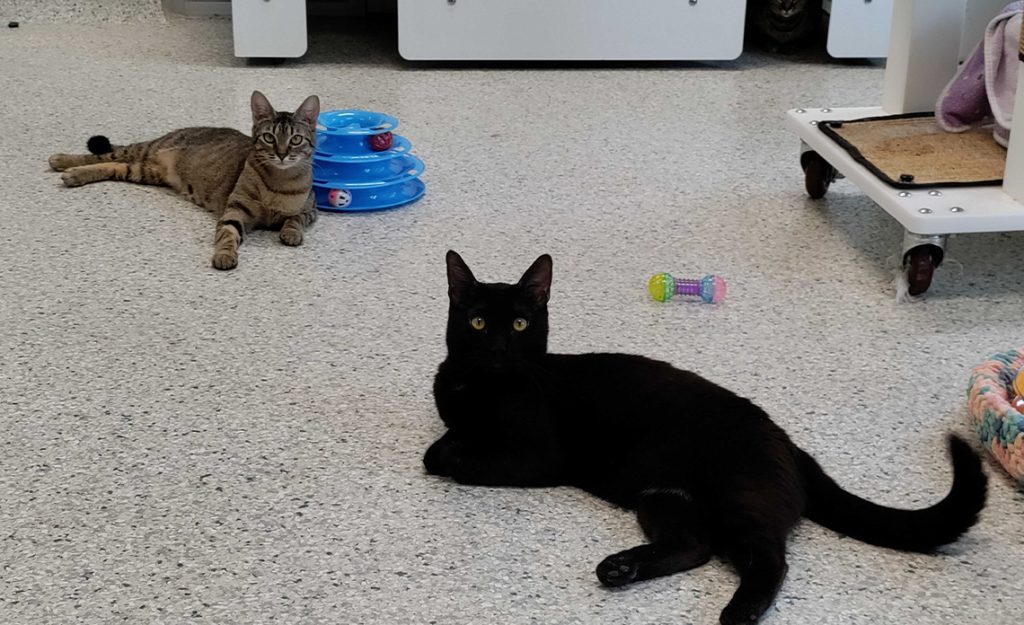The Adoption Behavior: What Do Cats Really Think About Their New Homes?

The Emotional Journey of Cats During Adoption
Bringing a cat into your home can be a life-changing experience for both you and your new furry friend. Understanding their adoption behavior is crucial for ensuring a smooth transition, as it allows you to cater to their emotional and physical needs during this critical time.
Cats are often perceived as aloof and independent, but they possess a rich emotional life that is worthy of exploration. When transitioning to a new home, a cat will showcase a variety of behaviors that reveal their feelings and coping mechanisms. Some key behaviors include:
- Curiosity: Upon arrival, a cat will likely explore every nook and cranny of their new surroundings. They might sniff at furniture, paw under cabinets, and even poke their heads into bags or boxes, eager to familiarize themselves with everything.
- Hide-and-seek: Cats instinctively search for safe spots where they can observe their new environment. This could mean retreating to a closet or behind furniture. Such hiding places provide them a sense of security as they adjust.
- Socialization: While some cats may be bold and approach their human companions immediately, others will adopt a more cautious approach, peeking out from their hiding spots before deciding to come closer and perhaps seek gentle affection.
The perception of a new home varies widely among individual cats, influenced by several factors that shape their adoption experiences. Understanding these factors can help you create an environment in which they feel comfortable:
- Age: Kittens often adapt quickly to new surroundings due to their innate curiosity and flexibility. In contrast, older cats may have established routines and will take more time to acclimate to their new life.
- Previous experiences: Cats coming from shelters or difficult situations may exhibit more wariness. For example, a cat that has faced neglect might initially be afraid of human interaction, manifesting in signs of fear or aggression.
- Environment: The physical layout of your home, including the presence of other pets, can significantly influence a cat’s comfort level. A cat might feel anxious in a chaotic house filled with young children and loud noises, while a quieter home might be more appealing.
By comprehensively understanding these dynamics, you can create a tailored experience that eases your cat’s transition period. Simple actions like providing a designated safe space, maintaining a consistent feeding schedule, and allowing the cat to initiate interactions can be invaluable. This article aims to delve deeper into these fascinating behavioral dynamics, offering greater insights on how to ensure that your new feline friend experiences a seamless integration into your household.
Ultimately, knowing how a cat perceives its new environment can lead not just to a smoother transition but also to a fulfilling relationship with your new companion. Your awareness can make all the difference in easing their fears and fostering a bond that lasts a lifetime.

DIVE DEEPER: Click here to learn more
Decoding Cat Behavior: Emotional Responses to Adoption
Understanding what your cat thinks about their new home involves decoding a variety of emotional responses and behaviors that can reveal their mental state during this transitional period. Cats may express their feelings through body language, vocalizations, and specific habits as they absorb the changes in their environment. Here are some key emotional responses to monitor:
- Body Language: A cat’s body language can be a significant indicator of their feelings. For instance, an arched back and puffed-up fur often signify fear or aggression, while a relaxed posture with a slow blink can indicate trust and comfort. Observing these signs can help pinpoint the emotional temperature of your new feline friend.
- Vocalizations: While some cats may be quiet in their new home, others might vocalize more often as a way to express their discomfort or simply to communicate their needs. Pay attention to the types of sounds they make; a soft meow could indicate a desire for engagement, while growling or hissing often points to stress or fear.
- Grooming Habits: Cats are meticulous groomers, and changes in grooming behavior can signal stress. If a cat begins to over-groom or stops grooming altogether, it may reflect their emotional struggles during the period of adjustment.
In addition to these behaviors, the way a cat interacts with their new environment reveals a lot about their thoughts on their new home. For example, a cat may display territorial behavior, such as rubbing their scent glands on furniture or scratching surfaces, to claim their space. This instinctual action is a natural part of their adjustment process, as they work to establish a sense of control and safety in their new territory.
The Role of Patience and Understanding
Each cat is unique, and patience is paramount when it comes to observing and interpreting their adoption behavior. Some may take a few days to acclimate, while others might require weeks or even months to feel at home. Keeping a keen eye on their behavioral signs allows you to provide the necessary support during this critical time. Here are a few practical tips to ease their transition:
- Establish Routines: Cats thrive on routine. Keeping feeding, playtime, and grooming consistent can help them find security in your home.
- Create a Safe Space: Providing a quiet area for your cat to retreat to can significantly reduce anxiety. Equip this space with bedding, litter, and some toys to create a comforting environment.
- Encourage Exploration: Allow your cat to explore their new surroundings at their own pace. Rushing them into social interactions can cause additional stress; instead, let them dictate the tempo of their acclimation.
Recognizing these emotional aspects of a cat’s adoption behavior not only enriches your understanding but also fortifies the bond you’ll build over time. The transition period is not just about physical changes; it’s deeply tied to emotional resilience, making it essential for adopters to approach this journey with empathy and care.
| Category | Considerations |
|---|---|
| Stress Response | Cats often experience high levels of anxiety when adjusting to new environments. Understanding their behavioral cues is essential. |
| Territory Establishment | Establishing territory can take time. Providing spaces for exploration enhances their comfort and reduces stress. |
The adoption behavior of cats is a complex interplay between their innate instincts and the new experiences they encounter in different homes. It’s vital to understand that when a cat enters a new environment, they may perceive it as a potential threat, triggering their survival instincts. This often leads to behaviors such as hiding or increased vocalizations as a means of expressing discomfort. Moreover, living in a new setting means that cats need to adapt not just to new human companions but also to the scents and sounds that permeate their surroundings. Integrating familiar objects—like blankets or toys from their previous home—can significantly aid in their transition. Additionally, the importance of territory shouldn’t be underestimated. Cats are inherently territorial creatures, and they feel more secure when they establish their own domain within the new space. Allowing them safe zones for retreat can make the adjustment smoother and usher in a sense of security. With a deeper understanding of these psychological factors, cat owners can foster a welcoming environment that enables these furry companions to settle in more comfortably, ultimately leading to a harmonious relationship with their new family.
LEARN MORE: Click here to discover the key to your pet’s health
Understanding the Impact of Environment on Cat Behavior
As we dive deeper into the topic of cat adoption behavior, it becomes apparent that environmental factors play a crucial role in how cats perceive their new homes. A cat’s habitat can significantly influence their emotional well-being and adaptation process. When analyzing how cats respond to their new surroundings, consider the following elements:
- Space and Layout: Cats are natural explorers that appreciate different nooks and crannies. An open layout can provide ample room for exploration and play, while cluttered spaces might overwhelm them. For instance, a multi-story house with elevated surfaces can offer them vertical space to roam. Cats often feel safer and more secure when they can survey their environment from above, reinforcing their confidence during the transition.
- Familiar Scents: A significant part of how cats interpret their environment comes from smell. Cats have a keen olfactory sense; introducing familiar scents, such as a blanket from their previous home or using pheromone diffusers, can help alleviate stress. This sensory anchor may remind them of positive experiences, thereby reinforcing their sense of safety.
- Noise Levels: The ambiance of a home—be it silent or bustling—can greatly impact a cat’s comfort level. Loud noises from traffic, household appliances, or children can amplify anxiety levels. Creating a calm atmosphere with soft music or minimal disturbances can help ease a cat into its new environment.
Social Dynamics and Bonding Through Adoption
Adopting a cat is not just about providing a physical home; it also involves establishing social dynamics which can affect their comfort in unfamiliar surroundings. The way cats interact with their human counterparts is vital to making them feel welcomed:
- Gradual Introduction: If your household has other pets, it’s essential to facilitate slow introductions. Cats can be territorial, and abrupt interactions may result in fear and stress. Introducing them through scent swapping or gradual visual contact can help pave the way for peaceful cohabitation.
- Positive Reinforcement: Encouraging desired behaviors with treats and affection can immensely help a cat associate their new experience with happiness. For instance, if your cat approaches you for a cuddle, rewarding this behavior can strengthen their trust in you.
- Quality Time: Engaging in play sessions can act as a bonding tool. Investing time in interactive toys or simple games like hide-and-seek can help alleviate anxiety and build a sense of companionship. The quality of your interactions can only improve as your cat becomes more comfortable in their new surroundings.
The complexities surrounding a cat’s adoption behavior highlight the importance of understanding the nuances of their emotional and environmental needs. By providing a supportive atmosphere rich in sensory comfort and positive engagement, you can significantly influence how a cat adapts to their new home, allowing their personality to flourish over time.
DISCOVER MORE: Click here to learn about your dog’s body language
Final Thoughts on Cat Adoption Behavior
In conclusion, understanding a cat’s adoption behavior is essential for creating a nurturing and harmonious home that caters to their intrinsic needs. Cats, with their unique personalities and emotional nuances, often perceive their new environments differently than we might expect. By recognizing the significance of environmental factors, such as space, familiar scents, and noise levels, we can better facilitate their transition from shelter to home. These elements not only define their comfort but also shape their long-term adjustment.
Moreover, fostering positive social dynamics through gradual introductions, affirmative interactions, and engaged play can transform the slow process of acclimatization into a rewarding journey of mutual trust and affection. As pet owners, it’s vital to appreciate that a cat’s bond with its new family is built over time, much like that of humans. Patience and understanding are essential elements in nurturing a successful relationship.
In a world where millions of cats are in need of loving homes, adopting a feline friend comes with profound responsibilities and joys. Those who take the time to comprehend “What Do Cats Really Think About Their New Homes?” will not only enrich their pet’s life but will also discover a deeper and more meaningful companionship. Each cat’s experience is unique, making continuous observation and adaptability key as they settle in. By investing in their emotional and environmental needs, we witness firsthand how these once-vulnerable animals can blossom into cherished members of our families.



